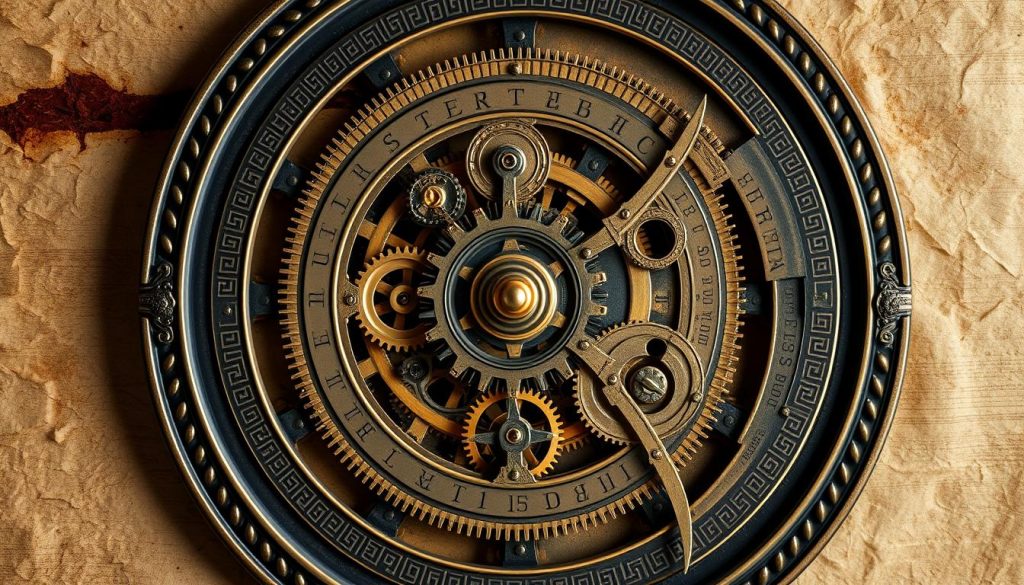The World’s First Robot: The Antikythera Mechanism
The Antikythera mechanism is known as the first analogue computer. It’s a stunning example of ancient Greek technology. It dates back to around 100 BCE, with a possible range of 70 years.
Anúncios
This device shows a deep understanding of astronomy and mechanics. It was found in a shipwreck off the Greek island of Antikythera in 1901. It has become a key interest for scholars and fans.
This complex device has 30 gear wheels. It was more than a scientific tool. It was a calendar and an astrological device, linking celestial events to cultural happenings like the Olympic Games.
The Antikythera mechanism is kept at the National Archaeological Museum of Athens. It shows the advanced technology of ancient civilizations. Its design lets it predict solar and lunar eclipses and the positions of planets.
This device’s ability and its historical importance make it very significant. It helps us understand the scientific progress of that time.
Anúncios
Introduction to the Antikythera Mechanism
The Antikythera mechanism is a stunning example of ancient Greek devices. It shows the advanced historical technology of its time. This device, measuring 34 cm × 18 cm × 9 cm, played a key role in early science.
Made in the 2nd century BC, it predicted the sun, moon, and planets’ movements. It also forecasted eclipses.
The device had 82 fragments, with four main pieces. These pieces had 30 bronze gears. The largest gear, about 13 cm in diameter, had 223 teeth.
This shows the ancient Greeks’ mechanical skill. The mechanism could predict astronomical events decades in advance. It used an epicyclic system for this.
Researchers found inscriptions on many fragments. These inscriptions talk about astronomical cycles and planetary motions. They show a link to Babylonian astronomy.
Despite studies, only about 33% of the device remains. This is a reminder of its mysterious past. It was found in a shipwreck from around 70–60 BC.
| Feature | Details |
|---|---|
| Construction Period | 2nd century BC (estimated 205 BC to 87 BC) |
| Size | 34 cm × 18 cm × 9 cm (13.4 in × 7.1 in × 3.5 in) |
| Largest Gear Diameter | 13 cm (5 in) with 223 teeth |
| Total Fragments | 82 |
| Main Fragments with Gears | 4 |
| Surviving Gears | 30 |
| Mechanism’s Predictive Capacity | Decades in advance |
| Influence | Babylonian astronomy |
This incredible device has sparked ongoing research. It shows the deep impact of ancient Greek innovation. The Antikythera mechanism is a key part of early scientific understanding.
History of the Antikythera Mechanism
The Antikythera mechanism is a blend of ancient Greek astronomy and technology. It’s over 2,000 years old. Found between 1900 and 1901, it was made between 150 to 100 BC.
This device has at least 82 pieces, like a mantel clock. Its design shows the skill of ancient Greek engineers. X-rays in the 1970s and 1990s uncovered its inner workings and inscriptions.
It tracks the Sun, Moon, and five planets with its gears. Fragment A shows the year’s cycle with four spokes. It also shows lunar and solar eclipses.
The mechanism mentions months for Corinth and its colonies. It also tracks major athletic festivals, like the Olympics. This shows its cultural importance.
It might have come from Rhodes, linked to philosopher Posidonius. Cicero mentioned a bronze device by Archimedes. The eclipse cycle comes from Babylon, dating back to 205 B.C.
Hipparchus, a famous astronomer in Rhodes, likely helped with the device. This shows a mix of art, science, and culture from ancient times.
| Feature | Details |
|---|---|
| Age | Over 2,000 years |
| Discovery Year | 1900 |
| Number of Pieces | 82 identified pieces |
| Size Comparison | Similar to a mantel clock |
| Notable Imaging Techniques | X-ray imaging, Polynomial Texture Mapping |
| Celestial Bodies Tracked | Sun, Moon, Mercury, Venus, Mars, Jupiter, Saturn |
| Significant Contributions | Hipparchus, Posidonius |
| Fragment A Features | Four spokes representing annual rotation |
| Percentage Survived | Approximately 33% |
| Link to Festivals | Tracking of Olympic games and other festivals |
Discovery of the Ancient Device
In 1901, sponge fishermen found the Antikythera mechanism near a shipwreck. This ship was a Roman cargo vessel, lying 45 meters deep. At first, it looked like just a piece of corroded metal. But in 1902, archaeologist Valerios Stais found its gear wheel, sparking curiosity.
The device’s design and mechanical parts showed it was more than just metal. It was an ancient astronomical calculator, made of 82 fragments. It dates back to between 60 and 70 B.C.E., possibly even 200 B.C.E.
It has 30 distinct gears, with the largest being 38-tooth. This gear works with a 127-tooth gear. It’s amazing because it tracks the moon’s 254 sidereal rotations every 19 years.
Studies have shown the Antikythera mechanism’s importance in ancient technology. It tracked the sun, moon, and five planets. This shows the ancient Greeks knew a lot about the sky.
Its discovery has changed how we see ancient technology. It’s a key find in archaeology, showing the ancient Greeks’ advanced knowledge.
Design and Construction of the Antikythera Mechanism
The Antikythera mechanism is a marvel of ancient technology. It had at least 30 meshing bronze gears, showing unmatched engineering skills. Each gear had a specific role, allowing it to accurately track celestial movements.
The mechanism was housed in a shoebox-like structure. It had dials and pointers that showed the sun and moon’s paths. This was a remarkable feat for its time.
The makers used copper, tin, and lead alloys for the mechanism. These materials made it strong and detailed. The device had 39 gears, including two crown gears, making it very functional.
It could predict things like lunar phases and eclipses. This was a huge step forward in ancient technology.
Today, researchers use modern methods to study the mechanism. They look at its gear systems and engineering. Replicating it shows how complex it was.

Studying the Antikythera mechanism is ongoing. It shows the ingenuity of ancient engineers. To learn more, visit this link.
Astronomical Functions and Capabilities
The Antikythera mechanism is an ancient device that shows amazing astronomical skills. It was made to predict solar and lunar eclipses and the movements of stars. This machine has over 40 gears, making it a complex system that models the orbits of the Moon and Sun.
This device could forecast eclipses using the Saros cycle. This helped people plan for events affected by these celestial events. It also tracked the Moon’s phases and gave info on major games like Isthmia and Olympia. This shows how much ancient Greeks knew about astronomy and its role in their culture.
| Astronomical Feature | Details |
|---|---|
| Predicts Eclipses | Utilizes the Saros cycle to forecast both solar and lunar eclipses. |
| Lunar Cycle Calculation | Accurately depicts the phases of the Moon. |
| Celestial Alignments | Shows specific celestial alignments for historical events. |
| Panhellenic Games | Provides data related to Isthmia, Olympia, Nemea, and Pythia games. |
| Gear Mechanism | Composed of over 40 individual gears enabling complex calculations. |
This device was not just for predicting events. It shows how far humans have come in understanding the universe. Its advanced gear system led to more discoveries in astronomy and engineering. It marks a key moment in the history of science.
The Science Behind the Antikythera Mechanism
The Antikythera mechanism is a blend of mathematics, engineering, and astronomy. It dates back to 150-100 BCE. This ancient device shows a deep understanding of ancient Greek astronomy and early gear technology.
Its design features about 30 interlocking gears. This is a sign of the advanced skills of Greek artisans. These gears allowed the mechanism to calculate complex things like the Metonic and Saros cycles. These cycles help predict solar and lunar eclipses.
The mechanism used a pin-and-slot system. This system made sure the gears moved at the right speeds. It accurately showed how the stars and planets move.

Derek de Solla Price’s work in 1974 was key. He showed how each gear was linked to a different celestial body. His ideas sparked interest, even though some were skeptical at first. Today, we know the Antikythera mechanism is the only ancient astronomical calculator left.
The mechanism also shows the knowledge from Babylon to Greece. People like Hipparchos played a big role in its creation. It shows the amazing skills of ancient Greek astronomy and gear technology that were unmatched for centuries.
Significance in Ancient Greek Culture
The Antikythera mechanism is a key part of ancient Greek culture. It shows their deep understanding of astronomical devices. This small device could track the sun, moon, and planets, showing the Greeks’ advanced knowledge.
It could also predict eclipses and the positions of planets. This was important because the Greeks believed in astrology. They used it to guide their decisions and activities.
The mechanism was a marvel of technology, unmatched until the late medieval period. It was likely used to teach people about the universe. This made it a powerful tool for learning about the cosmos.
The device helped people understand time in the universe. For example, it showed how long it takes Jupiter and Saturn to go through the zodiac. This shows the Greeks’ love for learning and understanding the universe.
They also believed in consulting the oracle of Apollo at Delphi before big decisions. The Antikythera mechanism might have played a role in this. It shows how astronomy and spirituality were closely linked in ancient Greek culture.
The following table summarizes key features and their implications for ancient Greek culture:
| Feature | Description | Significance |
|---|---|---|
| Size | Shoebox-sized | Compact design for complex functions |
| Astronomical Simulation | Tracks sun, moon, and planets | Demonstrates advanced astronomical knowledge |
| Event Linking | Incorporates Olympic game cycles | Connects societal events with astronomy |
| Technological Sophistication | Gears complexity | Showcases advanced engineering untapped for over a millennia |
| Educational Tool | Visual representation of cosmic concepts | Enhances teaching of cosmology |
| Cultural Weight | Influence of astrology | Speaks to the integration of science and belief systems |
Conclusion
The Antikythera mechanism is a stunning example of ancient technology and the Greeks’ advanced engineering. It dates back to the early 2nd century BCE. This device has at least 27 gears, more than any later timekeeping device.
It can track astronomical cycles like the Metonic cycle and Olympic Games. This shows the advanced science and curiosity of the ancient Greeks. They wanted to understand the universe better.
Studying the Antikythera mechanism helps us learn more about its past. It also makes us look at other ancient technologies in a new light. New finds from excavations keep changing how we see ancient science.
This shows that seeking knowledge is something humans have always done. It’s a never-ending quest.
In conclusion, the Antikythera mechanism shows the genius of the ancient civilization that made it. It still fascinates us today. This device proves that our technological journey has ancient roots.
